Case Study and Education on Hypertension and Rheumatic Fever
VerifiedAdded on 2023/01/19
|8
|1477
|49
AI Summary
This essay evaluates two care plans for hypertension and rheumatic fever, including the incidence, prevalence, and causes of hypertension, grading and management of hypertension, and education plans for patients with hypertension and rheumatic fever.
Contribute Materials
Your contribution can guide someone’s learning journey. Share your
documents today.
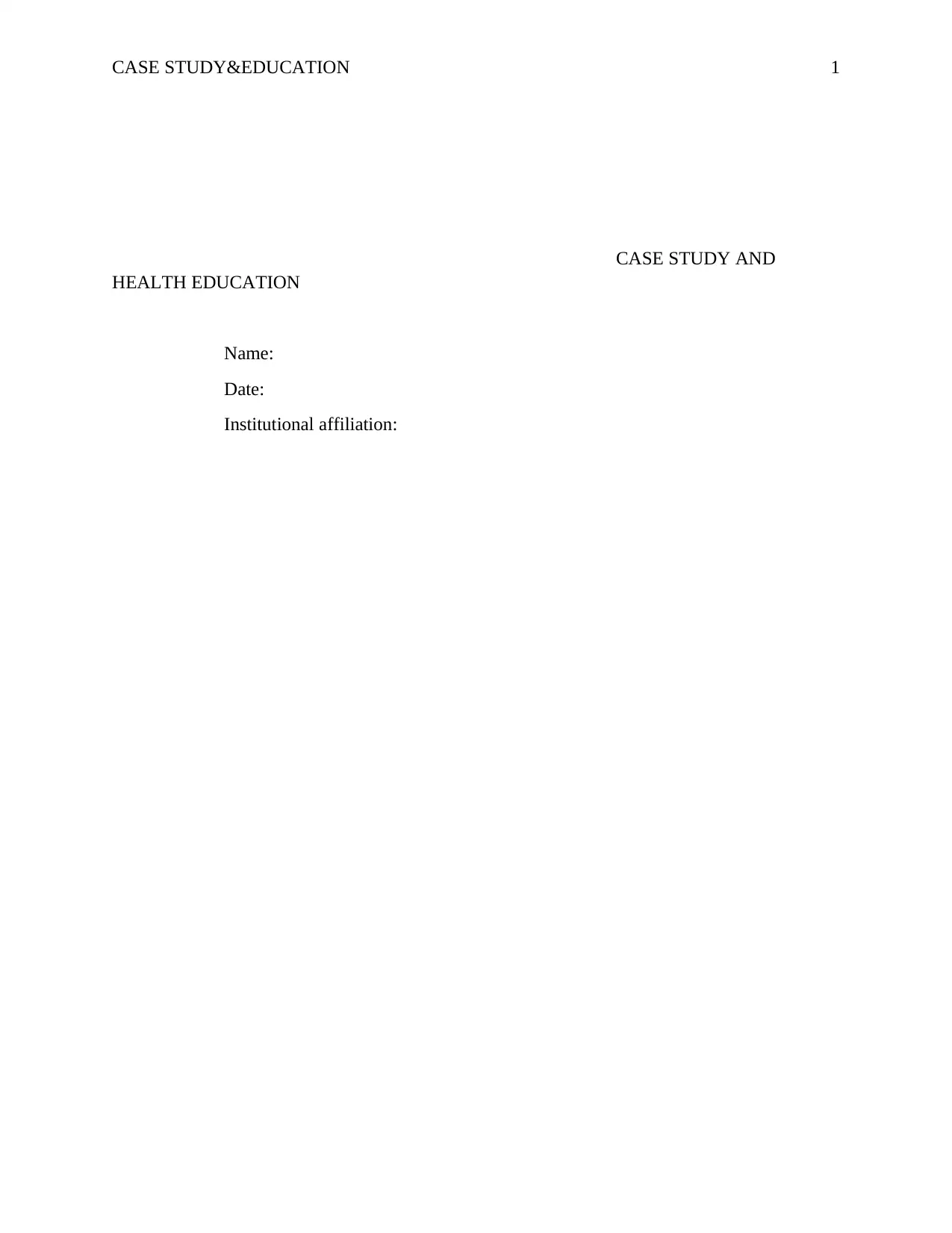
CASE STUDY&EDUCATION 1
CASE STUDY AND
HEALTH EDUCATION
Name:
Date:
Institutional affiliation:
CASE STUDY AND
HEALTH EDUCATION
Name:
Date:
Institutional affiliation:
Secure Best Marks with AI Grader
Need help grading? Try our AI Grader for instant feedback on your assignments.
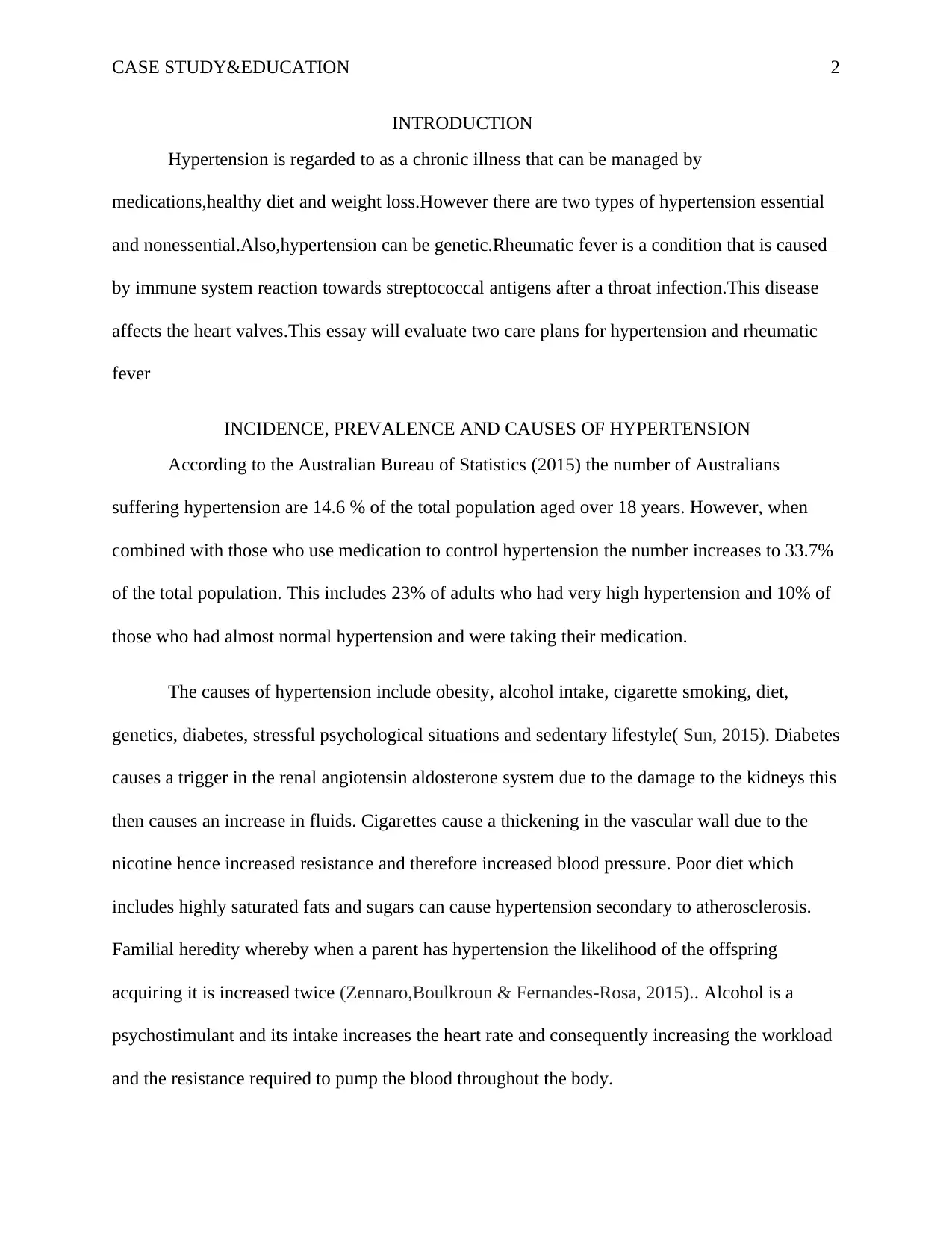
CASE STUDY&EDUCATION 2
INTRODUCTION
Hypertension is regarded to as a chronic illness that can be managed by
medications,healthy diet and weight loss.However there are two types of hypertension essential
and nonessential.Also,hypertension can be genetic.Rheumatic fever is a condition that is caused
by immune system reaction towards streptococcal antigens after a throat infection.This disease
affects the heart valves.This essay will evaluate two care plans for hypertension and rheumatic
fever
INCIDENCE, PREVALENCE AND CAUSES OF HYPERTENSION
According to the Australian Bureau of Statistics (2015) the number of Australians
suffering hypertension are 14.6 % of the total population aged over 18 years. However, when
combined with those who use medication to control hypertension the number increases to 33.7%
of the total population. This includes 23% of adults who had very high hypertension and 10% of
those who had almost normal hypertension and were taking their medication.
The causes of hypertension include obesity, alcohol intake, cigarette smoking, diet,
genetics, diabetes, stressful psychological situations and sedentary lifestyle( Sun, 2015). Diabetes
causes a trigger in the renal angiotensin aldosterone system due to the damage to the kidneys this
then causes an increase in fluids. Cigarettes cause a thickening in the vascular wall due to the
nicotine hence increased resistance and therefore increased blood pressure. Poor diet which
includes highly saturated fats and sugars can cause hypertension secondary to atherosclerosis.
Familial heredity whereby when a parent has hypertension the likelihood of the offspring
acquiring it is increased twice (Zennaro,Boulkroun & Fernandes-Rosa, 2015).. Alcohol is a
psychostimulant and its intake increases the heart rate and consequently increasing the workload
and the resistance required to pump the blood throughout the body.
INTRODUCTION
Hypertension is regarded to as a chronic illness that can be managed by
medications,healthy diet and weight loss.However there are two types of hypertension essential
and nonessential.Also,hypertension can be genetic.Rheumatic fever is a condition that is caused
by immune system reaction towards streptococcal antigens after a throat infection.This disease
affects the heart valves.This essay will evaluate two care plans for hypertension and rheumatic
fever
INCIDENCE, PREVALENCE AND CAUSES OF HYPERTENSION
According to the Australian Bureau of Statistics (2015) the number of Australians
suffering hypertension are 14.6 % of the total population aged over 18 years. However, when
combined with those who use medication to control hypertension the number increases to 33.7%
of the total population. This includes 23% of adults who had very high hypertension and 10% of
those who had almost normal hypertension and were taking their medication.
The causes of hypertension include obesity, alcohol intake, cigarette smoking, diet,
genetics, diabetes, stressful psychological situations and sedentary lifestyle( Sun, 2015). Diabetes
causes a trigger in the renal angiotensin aldosterone system due to the damage to the kidneys this
then causes an increase in fluids. Cigarettes cause a thickening in the vascular wall due to the
nicotine hence increased resistance and therefore increased blood pressure. Poor diet which
includes highly saturated fats and sugars can cause hypertension secondary to atherosclerosis.
Familial heredity whereby when a parent has hypertension the likelihood of the offspring
acquiring it is increased twice (Zennaro,Boulkroun & Fernandes-Rosa, 2015).. Alcohol is a
psychostimulant and its intake increases the heart rate and consequently increasing the workload
and the resistance required to pump the blood throughout the body.
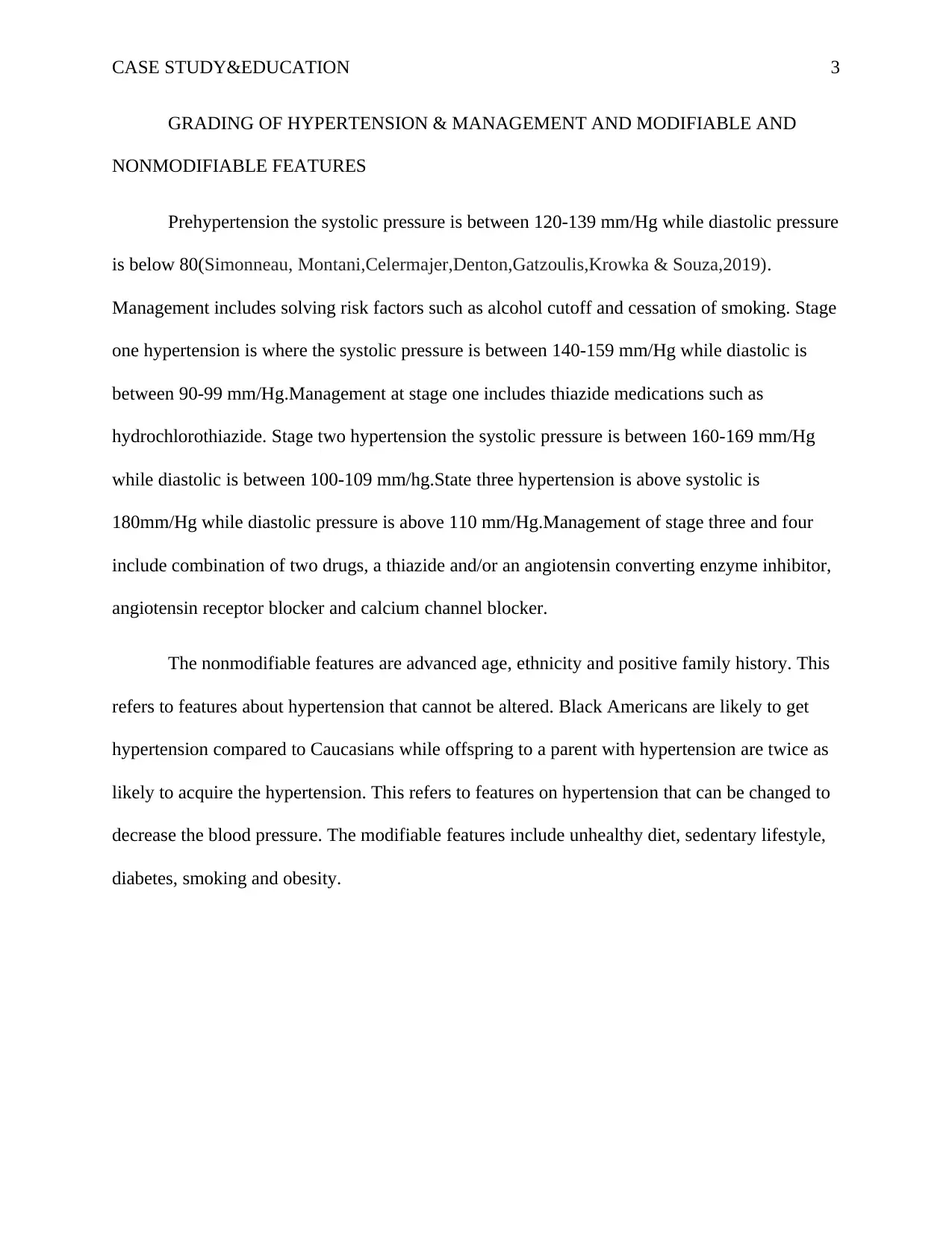
CASE STUDY&EDUCATION 3
GRADING OF HYPERTENSION & MANAGEMENT AND MODIFIABLE AND
NONMODIFIABLE FEATURES
Prehypertension the systolic pressure is between 120-139 mm/Hg while diastolic pressure
is below 80(Simonneau, Montani,Celermajer,Denton,Gatzoulis,Krowka & Souza,2019).
Management includes solving risk factors such as alcohol cutoff and cessation of smoking. Stage
one hypertension is where the systolic pressure is between 140-159 mm/Hg while diastolic is
between 90-99 mm/Hg.Management at stage one includes thiazide medications such as
hydrochlorothiazide. Stage two hypertension the systolic pressure is between 160-169 mm/Hg
while diastolic is between 100-109 mm/hg.State three hypertension is above systolic is
180mm/Hg while diastolic pressure is above 110 mm/Hg.Management of stage three and four
include combination of two drugs, a thiazide and/or an angiotensin converting enzyme inhibitor,
angiotensin receptor blocker and calcium channel blocker.
The nonmodifiable features are advanced age, ethnicity and positive family history. This
refers to features about hypertension that cannot be altered. Black Americans are likely to get
hypertension compared to Caucasians while offspring to a parent with hypertension are twice as
likely to acquire the hypertension. This refers to features on hypertension that can be changed to
decrease the blood pressure. The modifiable features include unhealthy diet, sedentary lifestyle,
diabetes, smoking and obesity.
GRADING OF HYPERTENSION & MANAGEMENT AND MODIFIABLE AND
NONMODIFIABLE FEATURES
Prehypertension the systolic pressure is between 120-139 mm/Hg while diastolic pressure
is below 80(Simonneau, Montani,Celermajer,Denton,Gatzoulis,Krowka & Souza,2019).
Management includes solving risk factors such as alcohol cutoff and cessation of smoking. Stage
one hypertension is where the systolic pressure is between 140-159 mm/Hg while diastolic is
between 90-99 mm/Hg.Management at stage one includes thiazide medications such as
hydrochlorothiazide. Stage two hypertension the systolic pressure is between 160-169 mm/Hg
while diastolic is between 100-109 mm/hg.State three hypertension is above systolic is
180mm/Hg while diastolic pressure is above 110 mm/Hg.Management of stage three and four
include combination of two drugs, a thiazide and/or an angiotensin converting enzyme inhibitor,
angiotensin receptor blocker and calcium channel blocker.
The nonmodifiable features are advanced age, ethnicity and positive family history. This
refers to features about hypertension that cannot be altered. Black Americans are likely to get
hypertension compared to Caucasians while offspring to a parent with hypertension are twice as
likely to acquire the hypertension. This refers to features on hypertension that can be changed to
decrease the blood pressure. The modifiable features include unhealthy diet, sedentary lifestyle,
diabetes, smoking and obesity.
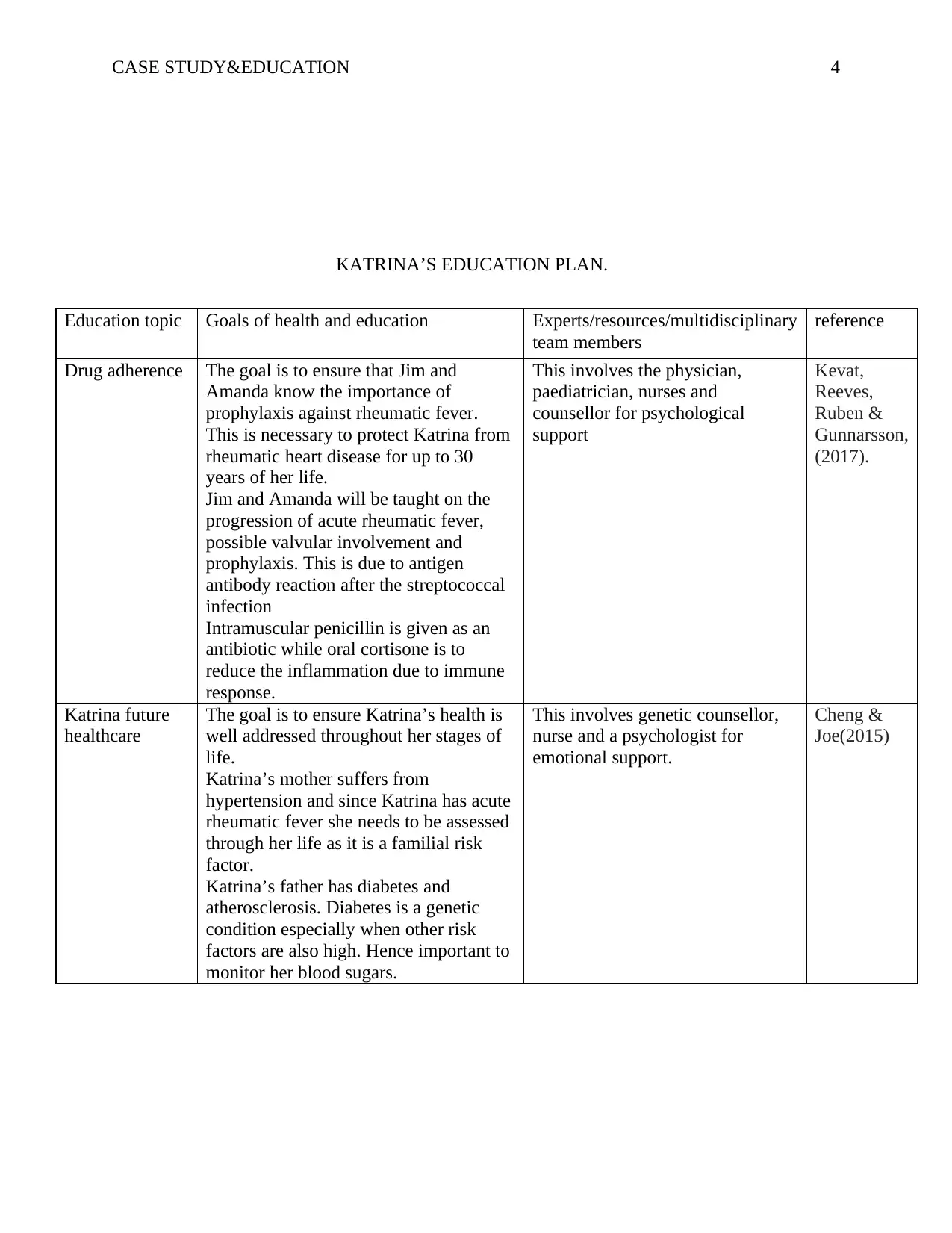
CASE STUDY&EDUCATION 4
KATRINA’S EDUCATION PLAN.
Education topic Goals of health and education Experts/resources/multidisciplinary
team members
reference
Drug adherence The goal is to ensure that Jim and
Amanda know the importance of
prophylaxis against rheumatic fever.
This is necessary to protect Katrina from
rheumatic heart disease for up to 30
years of her life.
Jim and Amanda will be taught on the
progression of acute rheumatic fever,
possible valvular involvement and
prophylaxis. This is due to antigen
antibody reaction after the streptococcal
infection
Intramuscular penicillin is given as an
antibiotic while oral cortisone is to
reduce the inflammation due to immune
response.
This involves the physician,
paediatrician, nurses and
counsellor for psychological
support
Kevat,
Reeves,
Ruben &
Gunnarsson,
(2017).
Katrina future
healthcare
The goal is to ensure Katrina’s health is
well addressed throughout her stages of
life.
Katrina’s mother suffers from
hypertension and since Katrina has acute
rheumatic fever she needs to be assessed
through her life as it is a familial risk
factor.
Katrina’s father has diabetes and
atherosclerosis. Diabetes is a genetic
condition especially when other risk
factors are also high. Hence important to
monitor her blood sugars.
This involves genetic counsellor,
nurse and a psychologist for
emotional support.
Cheng &
Joe(2015)
KATRINA’S EDUCATION PLAN.
Education topic Goals of health and education Experts/resources/multidisciplinary
team members
reference
Drug adherence The goal is to ensure that Jim and
Amanda know the importance of
prophylaxis against rheumatic fever.
This is necessary to protect Katrina from
rheumatic heart disease for up to 30
years of her life.
Jim and Amanda will be taught on the
progression of acute rheumatic fever,
possible valvular involvement and
prophylaxis. This is due to antigen
antibody reaction after the streptococcal
infection
Intramuscular penicillin is given as an
antibiotic while oral cortisone is to
reduce the inflammation due to immune
response.
This involves the physician,
paediatrician, nurses and
counsellor for psychological
support
Kevat,
Reeves,
Ruben &
Gunnarsson,
(2017).
Katrina future
healthcare
The goal is to ensure Katrina’s health is
well addressed throughout her stages of
life.
Katrina’s mother suffers from
hypertension and since Katrina has acute
rheumatic fever she needs to be assessed
through her life as it is a familial risk
factor.
Katrina’s father has diabetes and
atherosclerosis. Diabetes is a genetic
condition especially when other risk
factors are also high. Hence important to
monitor her blood sugars.
This involves genetic counsellor,
nurse and a psychologist for
emotional support.
Cheng &
Joe(2015)
Secure Best Marks with AI Grader
Need help grading? Try our AI Grader for instant feedback on your assignments.
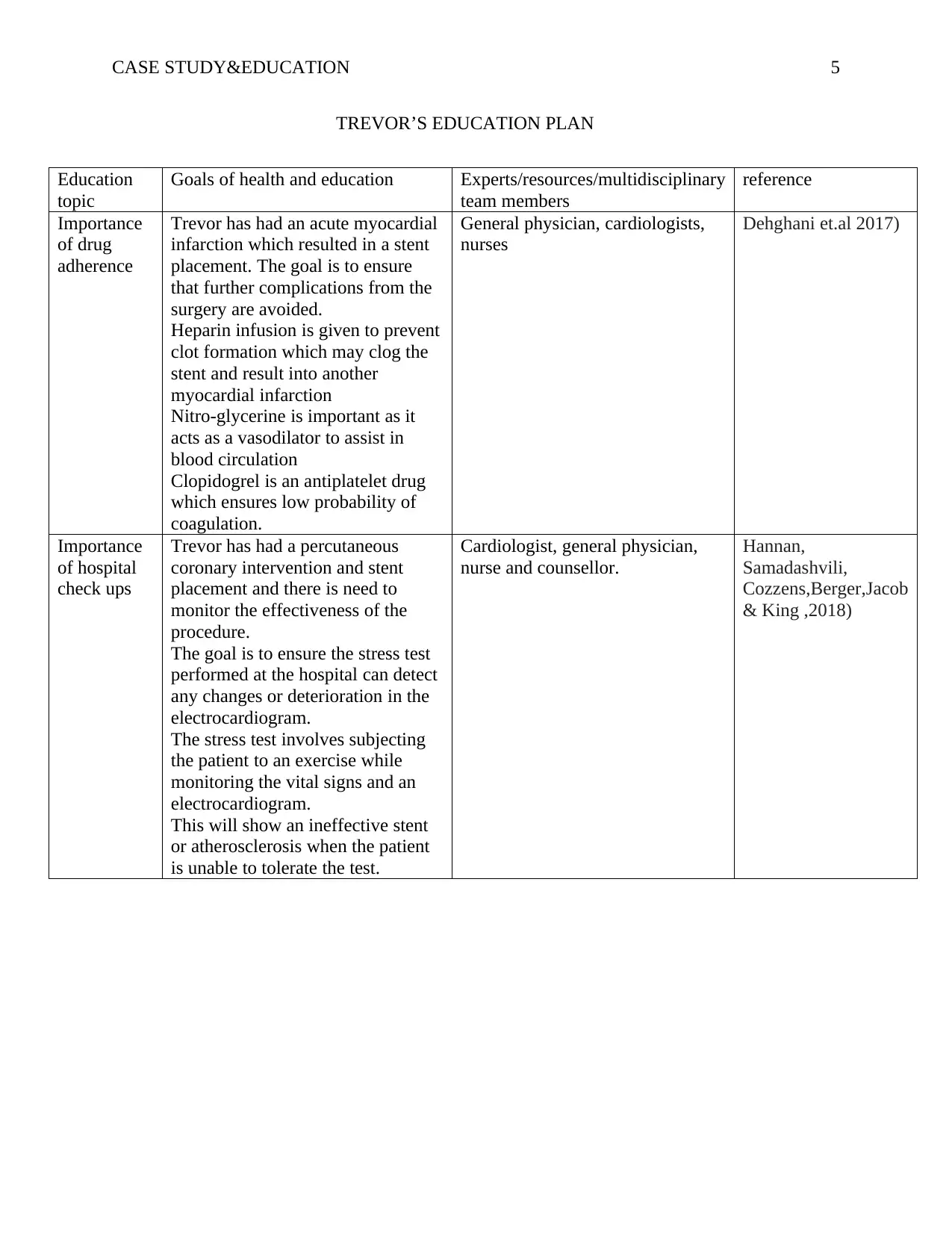
CASE STUDY&EDUCATION 5
TREVOR’S EDUCATION PLAN
Education
topic
Goals of health and education Experts/resources/multidisciplinary
team members
reference
Importance
of drug
adherence
Trevor has had an acute myocardial
infarction which resulted in a stent
placement. The goal is to ensure
that further complications from the
surgery are avoided.
Heparin infusion is given to prevent
clot formation which may clog the
stent and result into another
myocardial infarction
Nitro-glycerine is important as it
acts as a vasodilator to assist in
blood circulation
Clopidogrel is an antiplatelet drug
which ensures low probability of
coagulation.
General physician, cardiologists,
nurses
Dehghani et.al 2017)
Importance
of hospital
check ups
Trevor has had a percutaneous
coronary intervention and stent
placement and there is need to
monitor the effectiveness of the
procedure.
The goal is to ensure the stress test
performed at the hospital can detect
any changes or deterioration in the
electrocardiogram.
The stress test involves subjecting
the patient to an exercise while
monitoring the vital signs and an
electrocardiogram.
This will show an ineffective stent
or atherosclerosis when the patient
is unable to tolerate the test.
Cardiologist, general physician,
nurse and counsellor.
Hannan,
Samadashvili,
Cozzens,Berger,Jacob
& King ,2018)
TREVOR’S EDUCATION PLAN
Education
topic
Goals of health and education Experts/resources/multidisciplinary
team members
reference
Importance
of drug
adherence
Trevor has had an acute myocardial
infarction which resulted in a stent
placement. The goal is to ensure
that further complications from the
surgery are avoided.
Heparin infusion is given to prevent
clot formation which may clog the
stent and result into another
myocardial infarction
Nitro-glycerine is important as it
acts as a vasodilator to assist in
blood circulation
Clopidogrel is an antiplatelet drug
which ensures low probability of
coagulation.
General physician, cardiologists,
nurses
Dehghani et.al 2017)
Importance
of hospital
check ups
Trevor has had a percutaneous
coronary intervention and stent
placement and there is need to
monitor the effectiveness of the
procedure.
The goal is to ensure the stress test
performed at the hospital can detect
any changes or deterioration in the
electrocardiogram.
The stress test involves subjecting
the patient to an exercise while
monitoring the vital signs and an
electrocardiogram.
This will show an ineffective stent
or atherosclerosis when the patient
is unable to tolerate the test.
Cardiologist, general physician,
nurse and counsellor.
Hannan,
Samadashvili,
Cozzens,Berger,Jacob
& King ,2018)
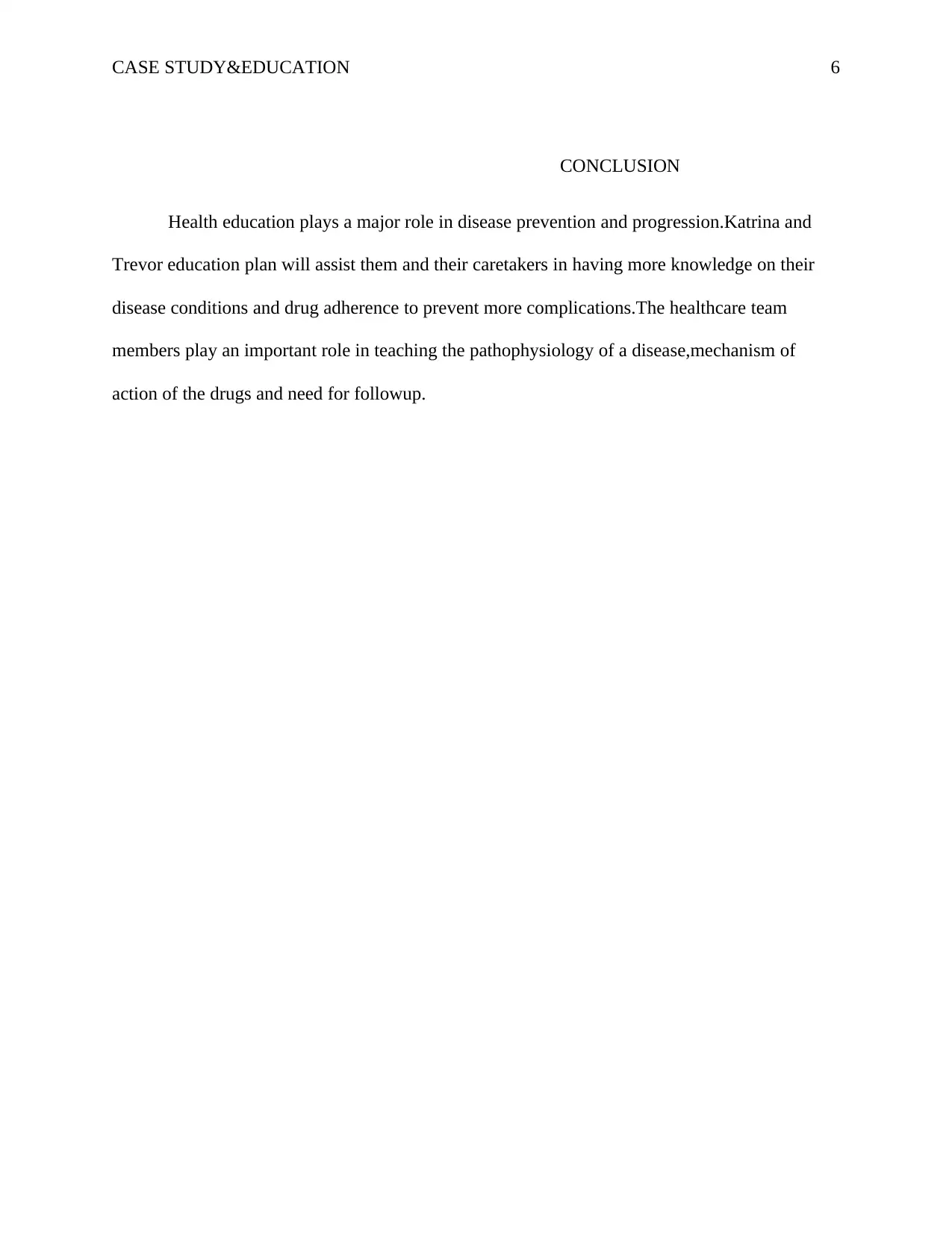
CASE STUDY&EDUCATION 6
CONCLUSION
Health education plays a major role in disease prevention and progression.Katrina and
Trevor education plan will assist them and their caretakers in having more knowledge on their
disease conditions and drug adherence to prevent more complications.The healthcare team
members play an important role in teaching the pathophysiology of a disease,mechanism of
action of the drugs and need for followup.
CONCLUSION
Health education plays a major role in disease prevention and progression.Katrina and
Trevor education plan will assist them and their caretakers in having more knowledge on their
disease conditions and drug adherence to prevent more complications.The healthcare team
members play an important role in teaching the pathophysiology of a disease,mechanism of
action of the drugs and need for followup.
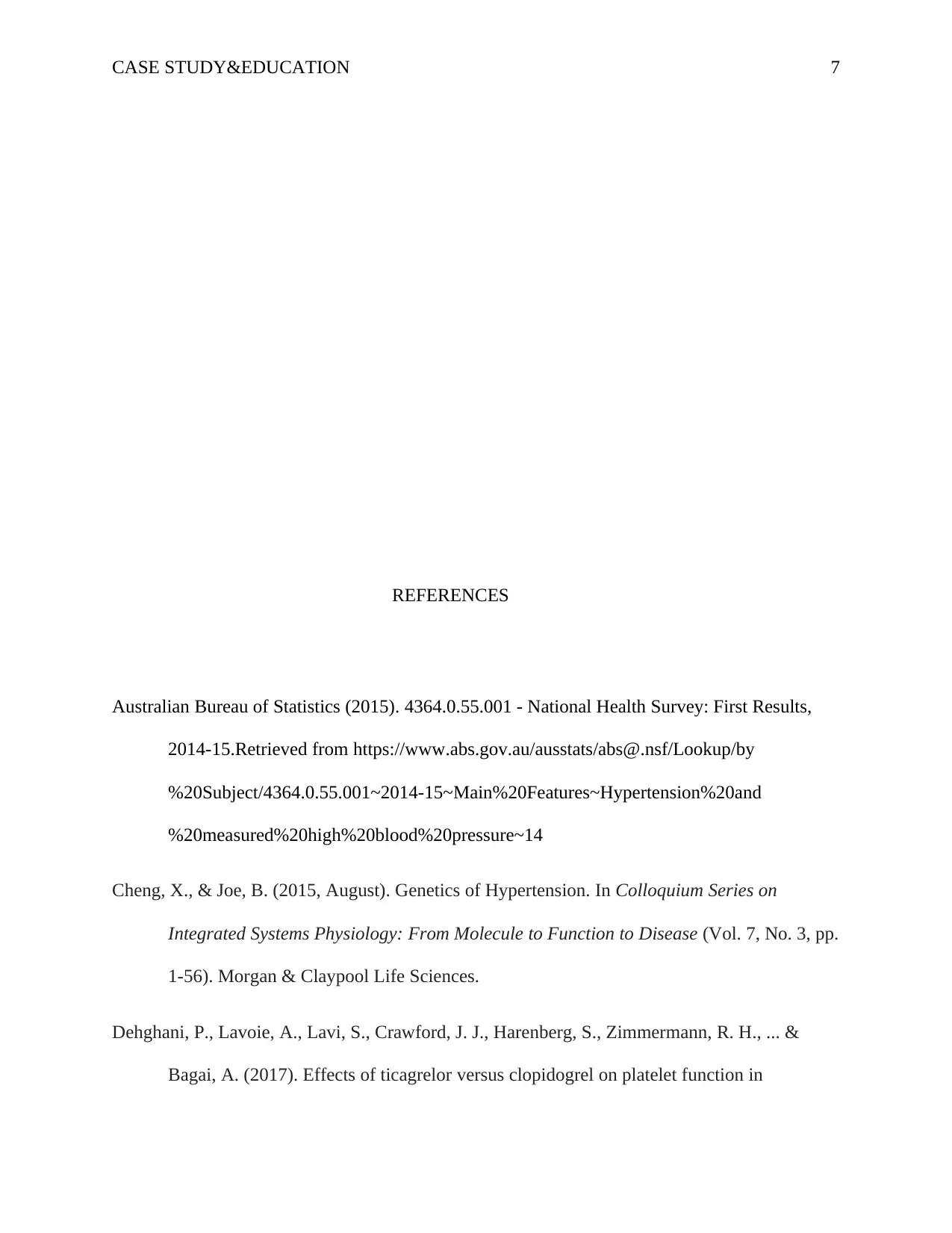
CASE STUDY&EDUCATION 7
REFERENCES
Australian Bureau of Statistics (2015). 4364.0.55.001 - National Health Survey: First Results,
2014-15.Retrieved from https://www.abs.gov.au/ausstats/abs@.nsf/Lookup/by
%20Subject/4364.0.55.001~2014-15~Main%20Features~Hypertension%20and
%20measured%20high%20blood%20pressure~14
Cheng, X., & Joe, B. (2015, August). Genetics of Hypertension. In Colloquium Series on
Integrated Systems Physiology: From Molecule to Function to Disease (Vol. 7, No. 3, pp.
1-56). Morgan & Claypool Life Sciences.
Dehghani, P., Lavoie, A., Lavi, S., Crawford, J. J., Harenberg, S., Zimmermann, R. H., ... &
Bagai, A. (2017). Effects of ticagrelor versus clopidogrel on platelet function in
REFERENCES
Australian Bureau of Statistics (2015). 4364.0.55.001 - National Health Survey: First Results,
2014-15.Retrieved from https://www.abs.gov.au/ausstats/abs@.nsf/Lookup/by
%20Subject/4364.0.55.001~2014-15~Main%20Features~Hypertension%20and
%20measured%20high%20blood%20pressure~14
Cheng, X., & Joe, B. (2015, August). Genetics of Hypertension. In Colloquium Series on
Integrated Systems Physiology: From Molecule to Function to Disease (Vol. 7, No. 3, pp.
1-56). Morgan & Claypool Life Sciences.
Dehghani, P., Lavoie, A., Lavi, S., Crawford, J. J., Harenberg, S., Zimmermann, R. H., ... &
Bagai, A. (2017). Effects of ticagrelor versus clopidogrel on platelet function in
Paraphrase This Document
Need a fresh take? Get an instant paraphrase of this document with our AI Paraphraser
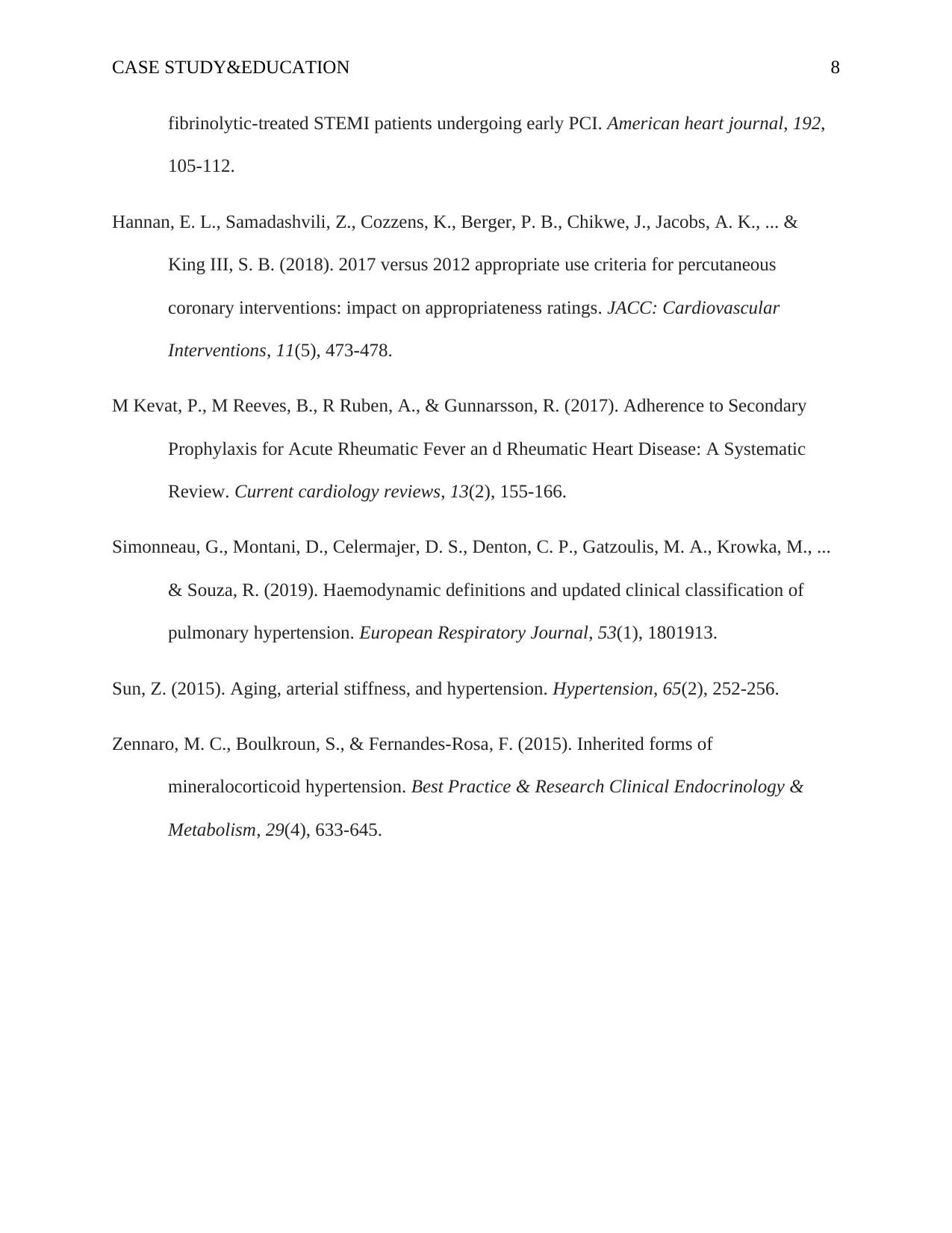
CASE STUDY&EDUCATION 8
fibrinolytic-treated STEMI patients undergoing early PCI. American heart journal, 192,
105-112.
Hannan, E. L., Samadashvili, Z., Cozzens, K., Berger, P. B., Chikwe, J., Jacobs, A. K., ... &
King III, S. B. (2018). 2017 versus 2012 appropriate use criteria for percutaneous
coronary interventions: impact on appropriateness ratings. JACC: Cardiovascular
Interventions, 11(5), 473-478.
M Kevat, P., M Reeves, B., R Ruben, A., & Gunnarsson, R. (2017). Adherence to Secondary
Prophylaxis for Acute Rheumatic Fever an d Rheumatic Heart Disease: A Systematic
Review. Current cardiology reviews, 13(2), 155-166.
Simonneau, G., Montani, D., Celermajer, D. S., Denton, C. P., Gatzoulis, M. A., Krowka, M., ...
& Souza, R. (2019). Haemodynamic definitions and updated clinical classification of
pulmonary hypertension. European Respiratory Journal, 53(1), 1801913.
Sun, Z. (2015). Aging, arterial stiffness, and hypertension. Hypertension, 65(2), 252-256.
Zennaro, M. C., Boulkroun, S., & Fernandes-Rosa, F. (2015). Inherited forms of
mineralocorticoid hypertension. Best Practice & Research Clinical Endocrinology &
Metabolism, 29(4), 633-645.
fibrinolytic-treated STEMI patients undergoing early PCI. American heart journal, 192,
105-112.
Hannan, E. L., Samadashvili, Z., Cozzens, K., Berger, P. B., Chikwe, J., Jacobs, A. K., ... &
King III, S. B. (2018). 2017 versus 2012 appropriate use criteria for percutaneous
coronary interventions: impact on appropriateness ratings. JACC: Cardiovascular
Interventions, 11(5), 473-478.
M Kevat, P., M Reeves, B., R Ruben, A., & Gunnarsson, R. (2017). Adherence to Secondary
Prophylaxis for Acute Rheumatic Fever an d Rheumatic Heart Disease: A Systematic
Review. Current cardiology reviews, 13(2), 155-166.
Simonneau, G., Montani, D., Celermajer, D. S., Denton, C. P., Gatzoulis, M. A., Krowka, M., ...
& Souza, R. (2019). Haemodynamic definitions and updated clinical classification of
pulmonary hypertension. European Respiratory Journal, 53(1), 1801913.
Sun, Z. (2015). Aging, arterial stiffness, and hypertension. Hypertension, 65(2), 252-256.
Zennaro, M. C., Boulkroun, S., & Fernandes-Rosa, F. (2015). Inherited forms of
mineralocorticoid hypertension. Best Practice & Research Clinical Endocrinology &
Metabolism, 29(4), 633-645.
1 out of 8
Related Documents
Your All-in-One AI-Powered Toolkit for Academic Success.
+13062052269
info@desklib.com
Available 24*7 on WhatsApp / Email
![[object Object]](/_next/static/media/star-bottom.7253800d.svg)
Unlock your academic potential
© 2024 | Zucol Services PVT LTD | All rights reserved.




